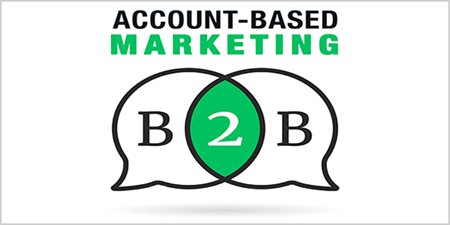Embracing Account-Based Marketing for Your B2B Strategy
By Gabriella Pirrone
August 24, 2018
ABM, Account-Based Marketing, B2B, B2B Content Marketing, B2B Marketing, Content Strategy, gartner, ROI, sales, sales cycle, Strategy, WCM
We’ve had a ton of feedback from our viewers wanting to know more on how they can leverage an Account-Based Marketing strategy for B2B audiences so I decided to break down the five fundamentals in my article below.
 What is Account Based Marketing?
What is Account Based Marketing?
"The account based marketing (ABM) approach applies to time-tested B2B marketing and sales principles to the challenge of selling to businesses by targeting company accounts
rather than individual sales leads. ABM creates hyper-personalized interactions—far more specific and relevant than traditional marketing—that enable sales and marketing teams to land more accounts and expand existing ones, even in the most complex sales environments."
According to ITSMA (a leading source for insight, community, and hands-on help for B2B marketers in the connected economy) about 85% of marketers who measure ROI describe account-based marketing as delivering higher returns than any other marketing approach.
But don’t forget, you can also leverage a WCM to execute an ABM strategy. In my colleague's previous article entitled “How to Utilize WCM to Support Your Account-Based Marketing” she perfectly outlines not just the importance of having an ABM strategy and technology in place but how it can also benefit your organization using her five processes:
“Like every strategy, developing and executing the right ABM strategy may take some time and lots of experiments. During this experimental period, buying an ABM technology is not necessary as you can kick it off with leveraging your existing content management system as well. Once you have defined the right strategy, you will know what capabilities are the most important to have for your organizations.”
Five Fundamentals for AMB Strategy for B2B
In a blog post by Steve Pogorzelski, former CEO of Avention OneSource Solutions, he stated that “Account-based marketing (ABM) continues to gain popularity among business-to-business (B2B) organizations looking to deepen engagement with specific accounts. In its 2016 State of ABM study, SiriusDecisions found that 92% of companies recognize ABM as a valuable solution to B2B marketing challenges.”
In a recent survey conducted by FlipMyFunnel’s 2017 State of Account-Based Marketing Survey, 81% of B2B marketers currently have an account-based marketing program in place and 83% of B2B marketers surveyed plan to expand their account-based marketing technology stack in the next year. Respondents in the survey also stated that they have plans to invest at some level in ABM education for their teams.
There is of course a ton of opinions and different types of implementations that come with account based marketing but in regards to educating your team, in my opinion, I think its really important for everyone to be on board and have the same end goal. Here is a list of the five fundamentals you should keep in mind when planning your AMB strategy for B2B:
Identify and Select Your Target Accounts: There’s no easy way to execute account-based marketing if you don’t know what accounts you’re targeting so what you need to do here is work in close conjunction with sales because ABM will not work if sales isn’t onboard, since it requires both marketing and sales to focus their resources on the defined set of target accounts. Once you have your sales team on board to build your initial list, you can then use lead scoring to help stack rank the accounts to make sure everyone is focused on the ones with the highest propensity to close.
Marketo has a really great webinar on how to turn your data into revenue with predictive lead scoring and clearly defines the following steps you should consider:
-
Profile your ideal customer so that you can target high-fit leads
-
Score your leads in real-time based on that profile
-
Optimally engage the leads by routing them to the appropriate nurture track or sales reps before even gathering behavioral data
Discover Personas and Map Target Accounts: You’ll want to then map your accounts to marketing personas next to better understand which divisions are the right ones to target. Here is where you will need to identify challenges that the account faces as a business, how decisions are made in the organization, and who makes those decisions. You can discover these next steps by discovering key contacts at each target account and mapping their relationships. Fill out each selected account and buying center with specific contacts based on ideal buyer profiles. Build a list of contacts from existing data, through manual collection, and via data vendors.
Develop Relevant Content: Remember that targeted customers are more likely to engage with content that is tailored specifically to them. This is because ABM is inherently more personalized, you’ll have a great opportunity to provide prospects from target accounts with content and messaging that resonates with them and is relevant to their business and stage in the buyer journey.
Deliver to Target Accounts: With contacts and content ready, it’s time to laser-focus the budget on the named people in the key accounts. This is where ABM takes the strengths of inbound marketing—valuable content, user-focused communication, etc.—and applies them to effective outbound strategies to close big accounts.
The most common interactions that marketers for AMB use are live event, webinars, direct mail, email, online advertising and web personalization.
Measure and Optimize Account Progress: Measuring, optimizing and analyzing your results over time will help you with continually optimizing your campaigns. Engagio lists the following five categories for ABM metrics very well:
-
Coverage - This is the most basic of the ABM metrics. Coverage is a measure of data quality and completeness, indicating whether or not the database has the right people in it. Where are there gaps in the data that will require list-building efforts?
-
Awareness - Do contacts know who the company is and what they do? This metric is notoriously difficult to measure, but two good places to start are branded web traffic and user interactions (such as opening emails).
-
Engagement - Are the right people at the account spending time with your company, and is that engagement going up over time? At Engagio, they measure engagement based on the number of minutes that a target contact spends with a brand.
-
Program Reach - Everyone wants to know what is working. In order to measure this, the team must first define “working.” For ABM, partly this means which marketing programs are reaching the right people target accounts (and conversely, how much waste is there in other programs).
-
Influence - The ABM program deserves credit for some wins, but long sales cycles with many touches can be difficult to track. Influence can be a softer science. Look for programs that create a lift in the key metrics that the company cares about, such as pipeline, deal velocity, and net promoter score.
Ending Notes
I hope this article has helped shed some light on your ABM marketing strategy. To a large extent, putting the “B” back in “B2B” means going back to marketing basics while applying the latest technology to help execute an ABM strategy.
Gartner predicts that by 2019, 75% of B2B TSPs with more than $10 million in revenue will adopt ABM as their primary market model, up from 25% in 2017. Gartner also said that account-based marketing (ABM) has been the fastest-growing go-to-market topic among Gartner TSP clients in the past year.

Gabriella Pirrone
Gabriella is the Digital Marketing Assistant for CMSC Media. She brings a wealth of knowledge from not only a CMS perspective but also content, SEO and eCommerce. She enjoys everything social media and staying ontop of the latest trends in the digital marketing world.